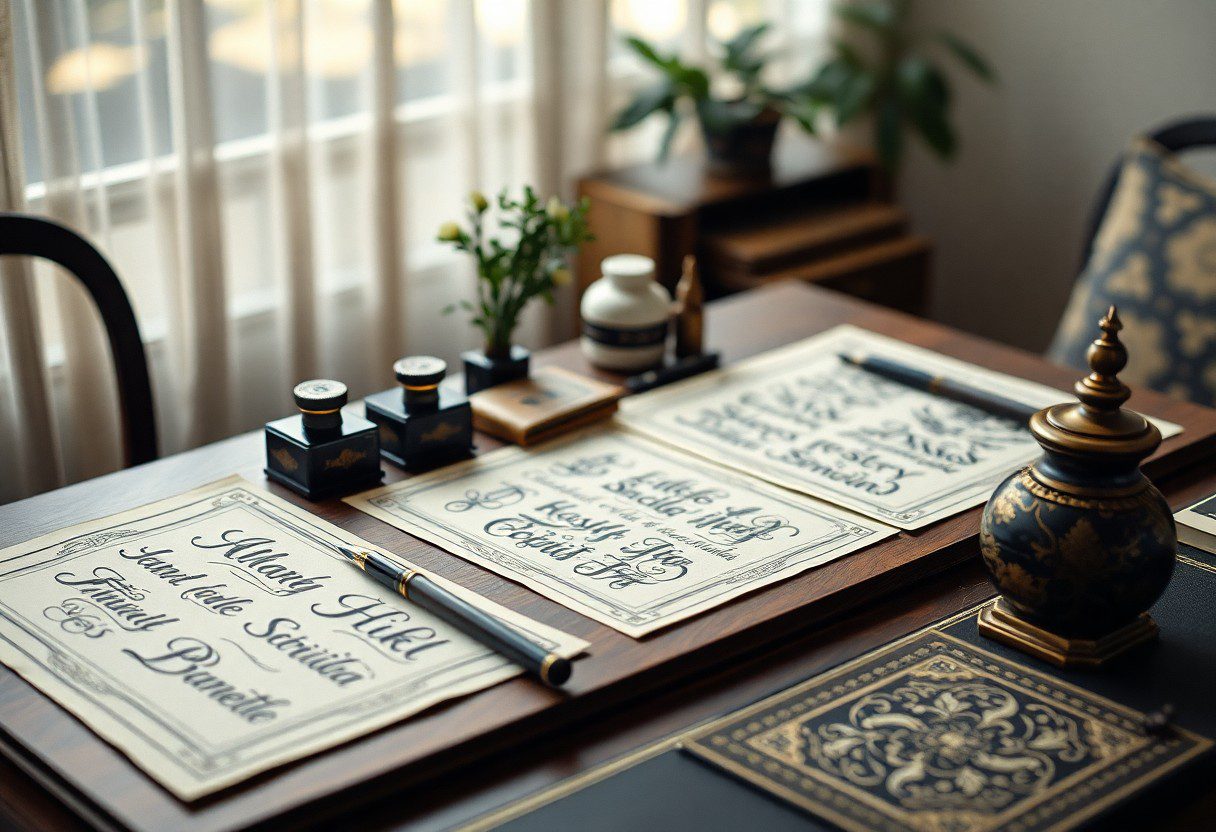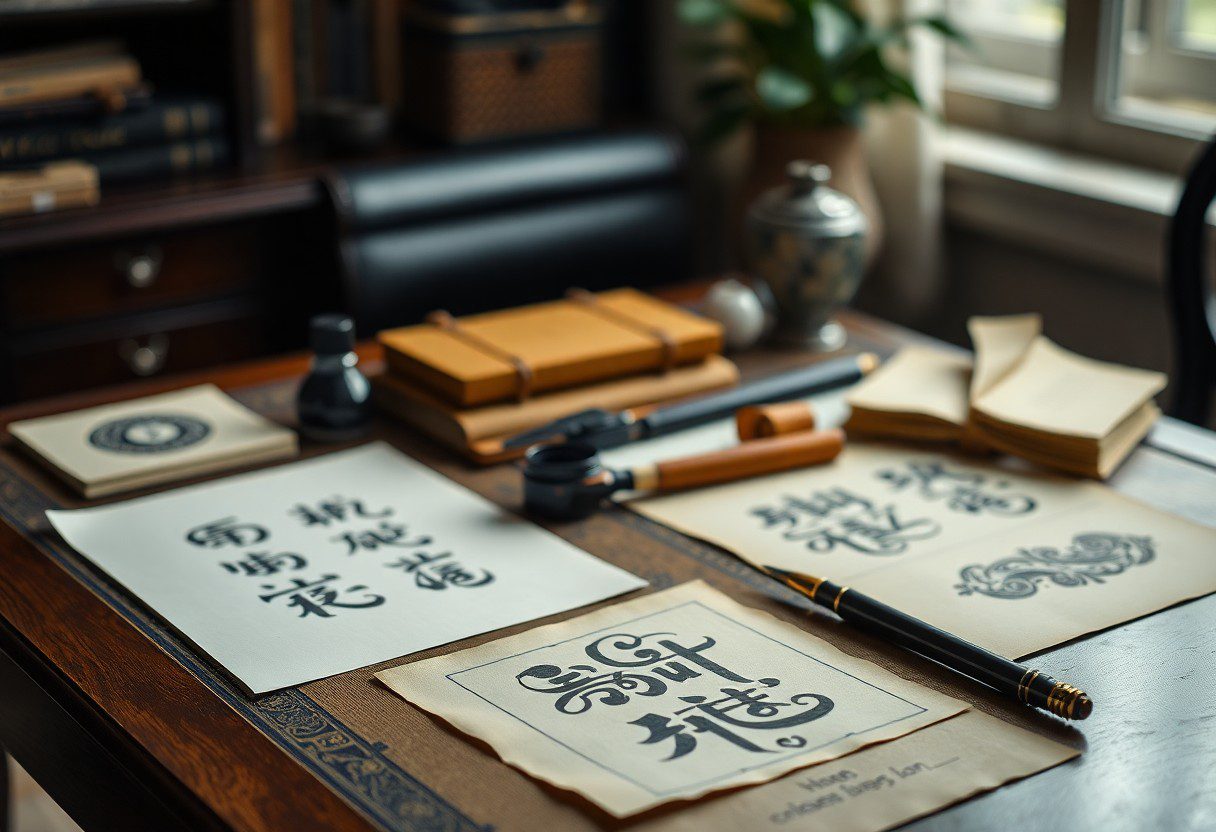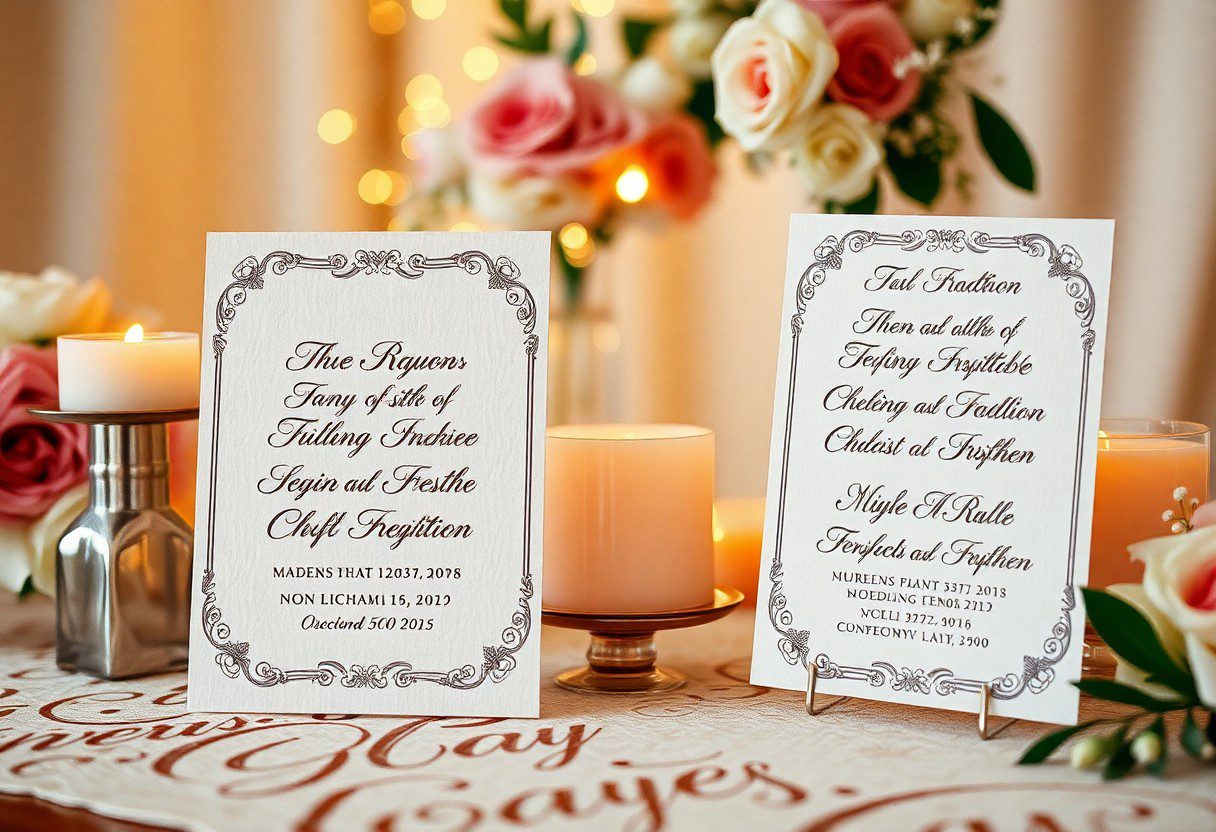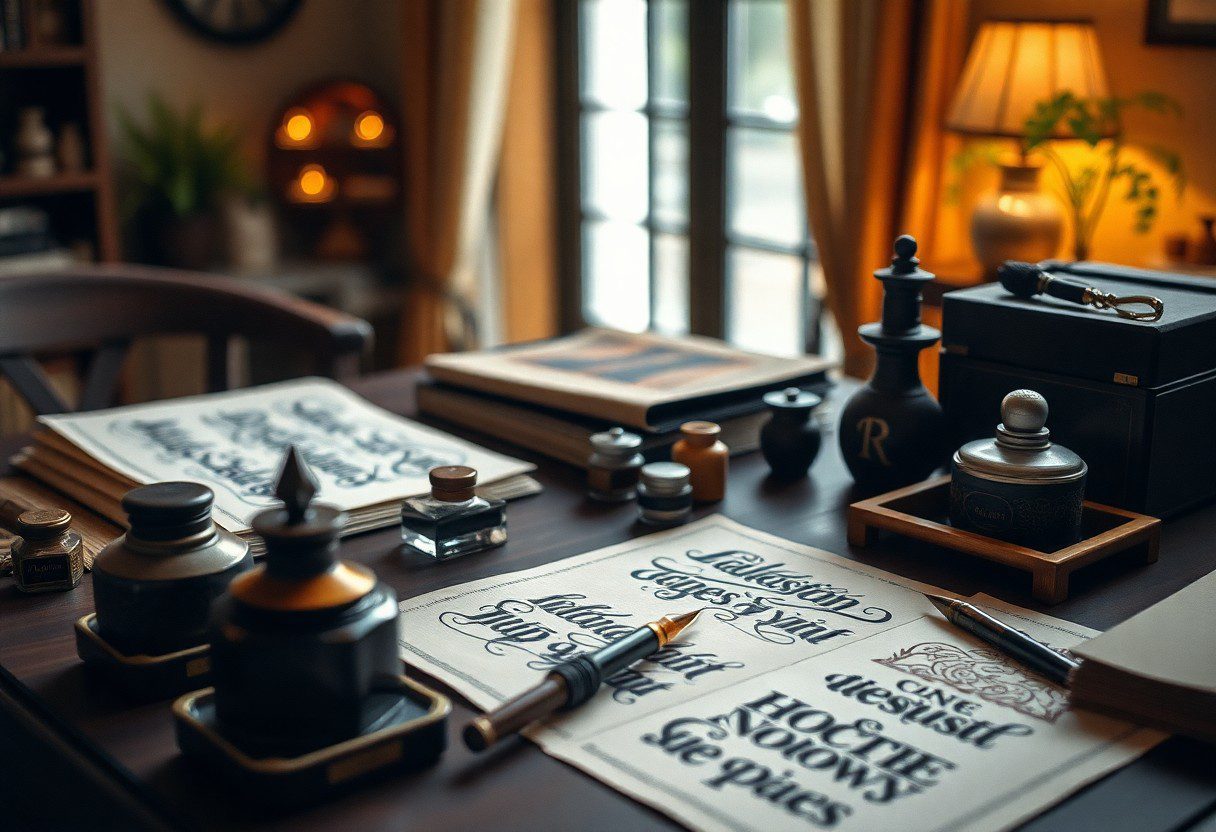Over the years, calligraphy has evolved into a popular art form that enhances your creativity and adds a personalized touch to your projects. With simple and engaging exercises, you can easily practice your skills at home, transforming everyday letters into stunning pieces of art. Whether you’re a beginner or looking to polish your technique, exploring various styles and techniques will keep your practice lively and enjoyable. In this blog post, you’ll discover easy calligraphy ideas that will not only improve your skillset but also boost your confidence as you begin on this rewarding journey.
Essential Tools for Calligraphy
Your journey into the art of calligraphy can be greatly enhanced by understanding the vital tools required for this beautiful craft. Having the right instruments not only makes the process easier but also inspires creativity and confidence in your writing. The two primary tools you’ll need to focus on are pens and nibs, as well as suitable paper types, each playing a vital role in the quality of your calligraphy work.
Pens and Nibs
For anyone starting in calligraphy, selecting the right pen and nib is fundamental. Many calligraphers prefer using dip pens, which allow greater control and flexibility. A standard dip pen setup typically consists of a pen holder and interchangeable nibs that can produce a variety of strokes and styles. You should also consider experimenting with brush pens, which are versatile and excellent for beginners.
| Pen Types | Description |
| Dip Pens | Allow for interchangeable nibs, offering various styles. |
| Brush Pens | Versatile and user-friendly for beginners. |
| Felt-tip Pens | Good for practice, though they lack precision. |
| Fountain Pens | Typically used for standard writing, less common in calligraphy. |
| Automatic Pens | Provide uniform lines, ideal for specific styles. |
Paper Types
Before you examine writing, choosing the appropriate paper is equally important as your choice of pen. The paper you use should ideally complement the ink flow and prevent bleeding, providing a smooth surface for your strokes. Some common types of paper include vellum, which offers a textured feel, and watercolor paper, which is thicker and absorbs ink beautifully. Additionally, you can experiment with smooth bristol paper for a more polished appearance.
| Paper Types | Characteristics |
| Vellum | Textured surface for added grip and control. |
| Watercolor Paper | Thick and absorbent, great for various inks. |
| Mixed Media Paper | Combines the best of both worlds, versatile. |
| Smooth Bristol Paper | Ideal for a polished and refined look. |
| Grid Paper | Helps with alignment and spacing. |
Nibs play a significant role in determining the outcome of your calligraphy work. They come in various shapes and sizes, each designed for specific styles and techniques. A flexible nib allows for dynamic strokes, while a stiffer nib results in more consistent lines. Make sure you find a nib that suits your personal style, as it’s vital for achieving the desired aesthetics. The
- nibs: available in various shapes, impacting line quality.
- flexible nibs: provide dynamic and expressive writing.
- stiff nibs: offer consistent lines and controlled strokes.
Basic Calligraphy Techniques
You can elevate your calligraphy skills by mastering basic techniques that form the foundation of beautiful lettering. Understanding and practicing various strokes and forms is the first step towards creating elegant letters. Each letter is composed of simple strokes, such as upward and downward movements, curves, and joins. By breaking down these strokes, you can practice whooshing motions with a consistent hand pressure that results in thick and thin lines. Use a grid or lined paper to help keep your strokes uniform, progressively combining them into more complicated forms to enhance your control and precision.
Strokes and Forms
To develop your calligraphy skills, you should dedicate time to practicing individual strokes before moving on to complete letters. Focus on mastering the basic forms, like loops, straight lines, and curves. Each of these strokes can be exaggerated through variations in pressure with your pen or brush, allowing you to create a dynamic flow that will contribute to your overall style. Consistency in your strokes also enables you to experiment with different styles, from ornate to minimalist, as you grow more confident in your technique.
Letter Connections
Techniques such as letter connections are crucial for achieving fluidity in your calligraphy. Connecting letters gracefully ensures that your writing is not only readable but also possesses an artistic rhythm. When transitioning from one letter to the next, consider the final stroke of the first letter and the starting stroke of the next. This intentional flow creates beautiful ligatures, enhancing the aesthetic appeal of your calligraphy.
Indeed, practicing letter connections can significantly enhance the overall appearance of your work. Focusing on the transitions between letters helps create a sense of unity in your calligraphy. Make sure to pay attention to the angles and curves that link the letters – these connections can either make or break the flow of your writing. Take the time to develop these connections, ensuring that they are smooth and consistent, and you’ll notice a remarkable improvement in the quality of your finished pieces.
Practicing Calligraphy Styles
One of the most enjoyable aspects of improving your calligraphy skills is exploring the different styles you can practice. Each style has its own unique flair and techniques, allowing you to express your creativity while mastering the art of writing beautifully. By dedicating time to practice various calligraphy styles, you will discover which resonates with you the most and enhances your overall artistic journey.
Modern Calligraphy
By integrating a blend of traditional techniques and contemporary creativity, modern calligraphy stands out as a vibrant and expressive option for you to explore. This style allows for more flexibility, so you can experiment with different letterforms and embellishments to create your unique interpretation. Make sure to gather the right tools, such as brush pens or pointed nibs, and select suitable paper that will help achieve the desired look. Don’t be afraid to play with varying line thicknesses and angles; this is a great way to let your individual style shine through!
Traditional Calligraphy
Calligraphy has deep historical roots, and traditional calligraphy encompasses various styles that have evolved over centuries. This art form typically emphasizes precision, so it’s imperative to practice foundational techniques, such as consistent pressure and control of your strokes. By focusing on specific scripts like Gothic, Italic, or Copperplate, you can build a strong skillset that will serve you well as you research into other styles.
With time, patience, and dedication, you can truly excel in traditional calligraphy. This art form often requires a fine-tipped pen or nib, along with high-quality ink and paper, to achieve those immaculate, flowing lines. Practicing consistency in your strokes and attention to detail will greatly enhance the elegance of your work. Allow this traditional style to instill discipline in your practice, fostering a sense of accomplishment as you see your skills evolve over time.
Creative Calligraphy Projects
Personalized Gifts
All you need to transform a simple item into a memorable gift is a touch of calligraphy. Across your creative journey, personalized gifts such as custom mugs, hand-lettered cards, or beautifully inscribed notebooks can be the perfect way to show your loved ones how much you care. Utilizing your skills, you can add a special touch to any gift—for birthdays, anniversaries, or even just because. Consider incorporating quotes or meaningful messages that resonate with the recipient, allowing you to convey heartfelt sentiments through your art.
Home Decor Ideas
On your path to enhancing your living space, calligraphy can be an excellent addition to your home decor. From framed quotes that inspire you daily to elegant wall art that reflects your personality, your ability to craft beautiful lettering can transform ordinary items into showstoppers. Create personalized signs for your kitchen, living room, or office space to enhance the ambiance and serve as a constant reminder of your creativity.
Plus, venturing into home decor ideas opens a world of possibilities. You can design stylish pillows with calligraphy phrases, paint inspirational words on canvas, or even ornament wooden boards with your favorite sayings. The key lies in choosing designs and colors that complement your space while allowing your calligraphy style to shine, ultimately creating a visually appealing environment that reflects your unique aesthetic. By embracing these projects, you can elevate your home while also honing your calligraphy skills!
Tips for Consistent Practice
Unlike many skills that require hands-on experience, calligraphy thrives on regular practice. Establishing a routine allows you to focus on improving your technique and developing your style. To ensure you stay on track, consider the following tips:
- Set aside a specific time each day for your practice.
- Choose a quiet space free of distractions.
- Keep your materials organized and accessible.
- Track your progress to see how far you’ve come.
- Join calligraphy groups online for accountability and inspiration.
Assume that by committing to a consistent schedule, you will find your skills improving steadily, allowing you to explore more complex styles and techniques.
Setting a Schedule
Consistent practice is vital for honing your calligraphy skills. By setting a schedule, you can allocate dedicated time to focus solely on your art. Consider establishing a daily routine where you engage with your materials, dedicate a few minutes to each session, and gradually increase the duration as you become more comfortable.
Start with manageable goals, like 15 minutes a day, then adjust as you progress. Whether you practice in the morning, during your lunch break, or in the evening, finding a time that suits your lifestyle will enhance your learning experience.
Maintaining Motivation
Along with setting a practice schedule, keeping your motivation high is vital in your calligraphy journey. You might find it beneficial to change up your practice activities regularly; this could include trying new techniques, experimenting with different tools, or setting personal challenges. Engage with others in the calligraphy community to share your journey, receive feedback, and inspire one another.
Tips to boost your motivation include setting personal milestones, celebrating your progress, and allowing yourself to explore creative projects that excite you. Surround yourself with inspiration, whether it’s through social media, video tutorials, or workshops to invigorate your passion for calligraphy. Don’t hesitate to tackle new styles or ideas, as this can inject energy into your routine and keep the practice enjoyable.
Online Resources for Calligraphy
Tutorials and Workshops
Workshops and online tutorials provide an excellent foundation for developing your calligraphy skills. You can easily find a plethora of free and paid resources ranging from fundamental strokes to advanced techniques. Platforms such as YouTube, Skillshare, and Udemy offer a variety of courses tailored for all skill levels. These materials guide you through different styles of calligraphy, including modern, traditional, and brush lettering. By dedicating some time to these structured workshops, you can significantly elevate your practice and discover new techniques that resonate with your personal style.
In addition to video tutorials, many websites host live workshops that allow for real-time interaction with instructors. Participating in these sessions can give you an advantage as you receive immediate feedback on your work, helping you correct mistakes and improve faster. Additionally, engaging in live classes makes the learning process more dynamic and helps you stay motivated in your calligraphy journey.
Community and Support
Along your calligraphy journey, connecting with a community can be immensely beneficial. Many online forums and social media groups exist where you can share your work, receive constructive feedback, and gain inspiration from fellow calligraphers. Engaging with a supportive community not only fosters your skills but also builds lasting friendships with those who share your passion. You may find these communities on platforms like Instagram, Facebook, and Reddit, where users regularly post their projects and offer advice.
Support from fellow calligraphers can enhance your learning experience significantly. Whether you are seeking critique on a new style or tips on creating a specific project, having access to a community makes the journey feel less isolating. You can also take advantage of group challenges and prompts that encourage creativity and push your boundaries. In a supportive environment, you’re more likely to stay committed to improving your skills while also enjoying the process.
Summing up
As a reminder, easy calligraphy ideas can serve as an excellent foundation for enhancing your skills from the comfort of your home. Whether you choose to practice simple alphabet strokes, engage in modern calligraphy projects, or incorporate seasonal themes, there are a wealth of resources available to guide you through each step. Tailoring your practice to suit your interests not only makes it enjoyable but also allows for continuous improvement in your technique.
Moreover, integrating these calligraphy exercises into your routine can help you develop a personalized style that reflects your artistic voice. By consistently dedicating time to explore various styles and mediums, you cultivate both confidence and proficiency in your calligraphy skills. So, gather your materials, set up a comfortable workspace, and watch your talents flourish as you commence on this creative journey.
FAQ
Q: What materials do I need to start practicing calligraphy at home?
A: To begin practicing calligraphy, you will need a few fundamental materials. First, invest in a quality calligraphy pen or a set of nibs if you prefer traditional calligraphy. Ink is important as well; you might opt for bottled ink or cartridges depending on your pen type. For practice paper, choose smooth, bleed-proof paper that allows the ink to flow well without feathering. Additionally, a ruler and pencil can help you create guideline spacing for letters, while a small eraser can assist with any corrections. Optional materials include calligraphy practice books or templates to guide your letter formations.
Q: How can I create a practice schedule for improving my calligraphy skills?
A: Establishing a practice schedule can enhance your calligraphy skills significantly. Start by dedicating a specific time each day or week for practicing; even 15-30 minutes can make a difference. Focus on practicing one letter or word at a time until you feel comfortable with it. You can also segment your practice sessions by focusing on different styles of calligraphy, such as modern, traditional, or brush lettering. Be sure to include time for freehand writing or creating small projects, as these help facilitate creativity while reinforcing your skills.
Q: What are some fun and creative projects I can try with my calligraphy skills?
A: There are endless fun projects to explore with calligraphy! Start with creating personalized greeting cards for friends and family, which can showcase your skills while making special occasions more meaningful. You can also try making hand-lettered quotes or inspirational phrases to frame and display at home. Another idea is to design custom stationery or bookmarks. For a seasonal twist, create calligraphy decorations for holidays, such as place cards for a dinner party or festive wall art. Additionally, consider collaborating with other artists to combine calligraphy with illustrations or watercolors for unique creations.
Q: How do I choose the right calligraphy style to practice?
A: Choosing the right calligraphy style largely depends on your personal taste and the purpose of your writing. Start by exploring different styles like modern, classical, italic, or copperplate to see which resonates with you. Research online or through calligraphy books to visualize various styles and their applications. If you’re planning to use your skills for specific events, like weddings or holidays, consider practicing styles that are appropriate for those occasions. Ultimately, the style that excites you the most will likely keep you motivated to practice regularly.
Q: Can online resources help me improve my calligraphy skills, and if so, which ones are recommended?
A: Absolutely! Online resources can significantly assist in improving your calligraphy skills. Many websites offer free tutorials, video lessons, and printable worksheets. Platforms like YouTube and Instagram are rich in demonstrations and inspiration from various calligraphers worldwide. Additionally, joining online communities or forums can provide valuable feedback and encouragement. Some popular websites for calligraphy resources include Skillshare, Creativebug, or even dedicated calligraphy blogs. Don’t hesitate to explore various online courses to find structured lessons that suit your learning style.





